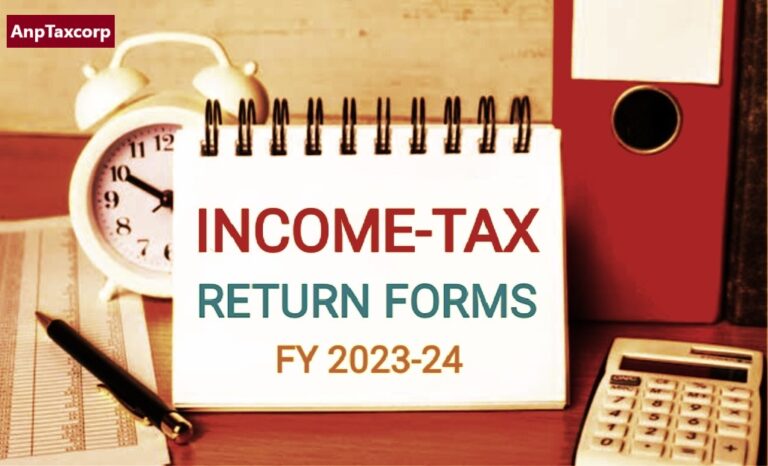A List of Changes in ITR Forms (ITR-1 to 6) Applicable for Financial Year 2023-24 (AY 2024-25)
ITR Form for AY 2024-25: As per the recent notifications of CBDT, specifically Notification No. 19 of 2024 dated January 31, 2024, ITR Forms 2, 3, and 5 have been officially released for Assessment Year (AY) 2024-25. Moreover, in Notification No. 16 of 2024 dated January 24, 2024, the introduction of ITR Form 6 for the same assessment year has been announced. Preceding these updates, on December 22, 2023, CBDT had notified ITR-1 and ITR-4 for AY 2024-25 through Notification No. 105 of 2023. It’s noteworthy that these forms are slated to be effective from April 1, 2024.
So, the Income Tax Department has recently released the Income Tax Return (ITR) forms, ranging from ITR-1 to ITR-6, applicable for the financial year 2023-24 (AY 2024-25). These new ITR forms come with significant changes, crucial from the taxpayers’ perspective. In this article, we aim to outline these modifications in the ITR forms, providing valuable insights for our readers to stay informed and ensure a smooth return filing process for the FY 2023-24.
Choice of Tax Regime
In the revamped ITR-1 form, taxpayers must specify their chosen tax regime, either old or new. While the new concessional tax regime is now default, individuals retain the option to revert to the old regime by filing Form 10-IEA while filing form ITR-4.
Deduction Under Section 80 CCH
ITR-1 is designed for individuals with simple income structures, excluding those with business income, capital gains, or double taxation relief. Specific eligibility criteria apply, such as total income up to Rs 50 lakh and ownership of one house property. Conversely, ITR-4 (SUGAM) targets individuals, HUFs, and firms opting for presumptive taxation under sections 44AD or 44AE.
New columns in ITR-1 and 4 allow disclosure of deductions under section 80 CCH. This includes deductions for individuals enrolled in the Agnipath Scheme and contributing to the Agniveer Corpus Fund after November 1, 2022.
Ease in Criteria for Businesses
Businesses opting for presumptive taxation under section 44AD benefit from eased criteria. A new ‘receipts in cash’ column discloses cash turnover, with the threshold raised to Rs. 3 crores, provided cash receipts don’t exceed 5% of total turnover.
Additional Details in ITR-6
ITR-6, utilized by companies, now demands additional details. This includes Legal Entity Identifier (LEI), MSME registration number, reasons for tax audit under section 44AB, disclosure of winnings from online games taxable under section 115 BBJ, and virtual digital assets.
Additionally, a new clause disallows deductions under section 43B for sums payable to micro or small enterprises not settled within the specified time frame of the MSME Act.
Applicability of different ITR Forms
ITR-1 (SAHAJ): This form is tailored for resident individuals whose total income does not exceed Rs. 50 lakh. It’s suitable for those earning income from salaries, one house property, and other sources.
ITR-2: Designed for individuals and Hindu Undivided Families (HUFs) who do not have income from business or profession.
ITR-3: Specifically crafted for individuals who earn income from business or profession.
ITR-4 (SUGAM): Geared towards resident individuals, HUFs, and firms (excluding Limited Liability Partnerships or LLPs) with total income up to Rs. 50 lakh. It’s applicable for those earning income from business and profession under sections 44AD, 44ADA, or 44AE.
ITR-5: Meant for entities other than individuals, HUFs, and companies. This includes partnership firms and LLPs.
ITR-6: This form is for companies that do not claim exemption under section 11 of the Income Tax Act.
Conclusion
The recent changes in ITR forms brings forth significant enhancements tailored to improve the filing experience for taxpayers. Aligned with amendments in the Income-tax Act, 1961, under the Finance Act, 2023, these changes aim to streamline the filing process, making it more user-friendly and convenient for individuals. With a focus on enhancing ease of filing, taxpayers can expect a smoother and more efficient experience when submitting their returns.
Staying abreast of these changes in ITR forms is crucial for taxpayers to ensure compliance with the updated ITR forms for FY 2023-24. Understanding these alterations facilitates smooth tax filing and adherence to regulations.
To Access the CBDT Notification 16/2024 on Release of ITR-6 CLICK HERE
To Access the CBDT Notification 105/2023 on Release of ITR-1 & ITR-4 CLICK HERE
To Download the CBDT Notification 19/2024 on Release of ITR-2, 3 & 5 CLICK HERE
Read More
Capital Gain on Sale of Land as per IT Act 1961: A Comprehensive Guide

you are in reality a just right webmaster The site loading velocity is incredible It seems that you are doing any unique trick In addition The contents are masterwork you have performed a wonderful task on this topic